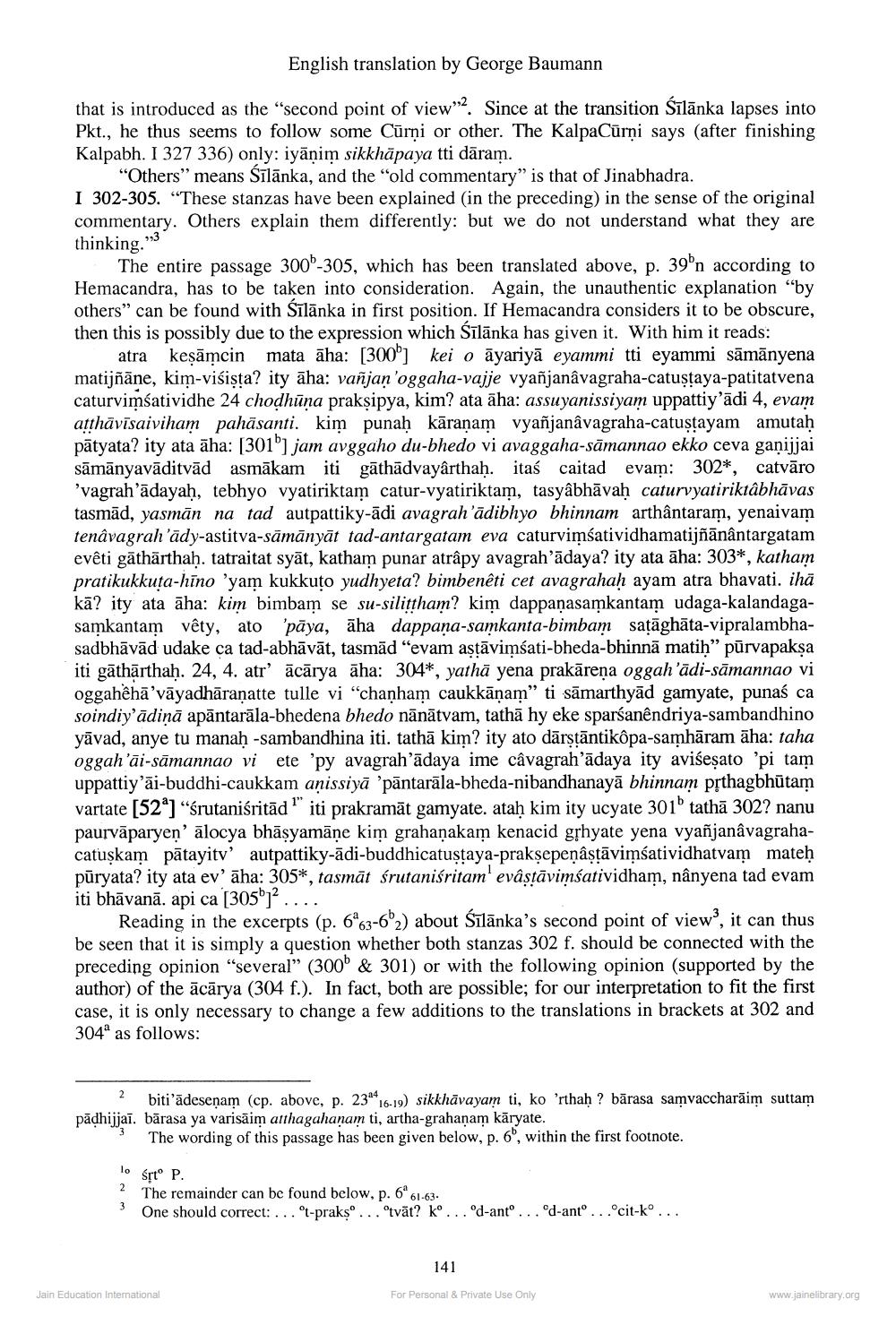________________
English translation by George Baumann
that is introduced as the "second point of view"2. Since at the transition Śīlānka lapses into Pkt., he thus seems to follow some Cūrņi or other. The KalpaCūrņi says (after finishing Kalpabh. I 327 336) only: iyānim sikkhāpaya tti dāram.
“Others" means Sīlānka, and the "old commentary” is that of Jinabhadra. I 302-305. "These stanzas have been explained (in the preceding) in the sense of the original commentary. Others explain them differently: but we do not understand what they are thinking."
The entire passage 300-305, which has been translated above, p. 39'n according to Hemacandra, has to be taken into consideration. Again, the unauthentic explanation "by others" can be found with Sīlānka in first position. If Hemacandra considers it to be obscure, then this is possibly due to the expression which Śīlānka has given it. With him it reads:
atra keşāmcin mata āha: [300'] kei o āyariyā eyammi tti eyammi sāmānyena matijñāne, kim-visista? ity āha: vañjan'oggaha-vajje vyañjanâvagraha-catustaya-patitatvena caturvimšatividhe 24 chodhūņa praksipya, kim? ata āha: assuyanissiyam uppattiy'ādi 4, evam atthāvīsaiviham pahāsanti. kim punah kāranam vyañjanâvagraha-catustayam amutah pātyata? ity ata āha: [301'] jam avggaho du-bhedo vi avaggaha-sāmannao ekko ceva ganijjai sāmānyavāditvād asmākam iti gāthādvayârthah. itaś caitad evam: 302*, catvāro 'vagrah'ādayah, tebhyo vyatiriktam catur-vyatiriktam, tasyâbhāvaḥ caturvyatiriktâbhāvas tasmād, yasmān na tad autpattiky-ādi avagrah'ādibhyo bhinnam arthântaram, yenaivam tenâvagrah'ādy-astitva-sāmānyāt tad-antargatam eva caturviņšatividhamatijñānântargatam evêti gāthārthah. tatraitat syāt, katham punar atrâpy avagrah’ādaya? ity ata āha: 303*, katham pratikukkuta-hino 'yam kukkuțo yudhyeta? bimbenêti cet avagrahaḥ ayam atra bhavati. ihā kā? ity ata āha: kim bimbam se su-silittham? kim dappanasamkantam udaga-kalandagasamkantam vêty, ato 'pāya, āha dappaņa-samkanta-bimbam sațāghāta-vipralambhasadbhāvād udake ca tad-abhāvāt, tasmā "evam astāvimsati-bheda-bhinnā matih” pūrvapaksa iti gāthārthah. 24, 4. atr' ācārya āha: 304*, yathā yena prakāreņa oggah'ādi-sāmannao vi oggahệhā'vāyadhāraṇatte tulle vi "chanham caukkāņam” ti sāmarthyād gamyate, punaś ca soindiy'ādiņā apāntarāla-bhedena bhedo nānātvam, tathā hy eke sparśanêndriya-sambandhino yāvad, anye tu manah -sambandhina iti. tathā kim? ity ato dārstāntikôpa-samhāram āha: taha oggah'āi-sāmannao viete 'py avagrah’ādaya ime câvagrah’ādaya ity aviseșato 'pi tam uppattiy'āi-buddhi-caukkam aņissiyā 'pāntarāla-bheda-nibandhanayā bhinnam prthagbhūtam vartate [529] "śrutanisritād " iti prakramāt gamyate. ataḥ kim ity ucyate 301 tathā 302? nanu paurvāparyen'ālocya bhāsyamāne kim grahaņakam kenacid grhyate yena vyañjanâvagrahacatuṣkam pātayitv'autpattiky-ādi-buddhicatustaya-prakṣepeņâștāviņśatividhatvam mateh pūryata? ity ata ev' āha: 305*, tasmāt śrutaniśritam' evâstāvimśatividham, nânyena tad evam iti bhavana. api ca [305°°....
Reading in the excerpts (p. 6o63-6'2) about Śīlānka's second point of view, it can thus be seen that it is simply a question whether both stanzas 302 f. should be connected with the preceding opinion "several” (3000 & 301) or with the following opinion (supported by the author) of the ācārya (304 f.). In fact, both are possible; for our interpretation to fit the first case, it is only necessary to change a few additions to the translations in brackets at 302 and 304 as follows:
2 biti'ādesenam (cp. above, p. 234416-19) sikkhāvayam ti, ko 'rthah ? bārasa samvaccharāim suttam pādhijjai. bārasa ya varisāim atthagahanam ti, artha-grahaņam kāryate.
The wording of this passage has been given below, p. 6', within the first footnote.
lo śrto P.
2 The remainder can be found below, p. 661-63. 3 One should correct: ... t-prakso... "tvāt? ko...od-anto... d-anto...cit-ko...
141
Jain Education International
For Personal & Private Use Only
www.jainelibrary.org




